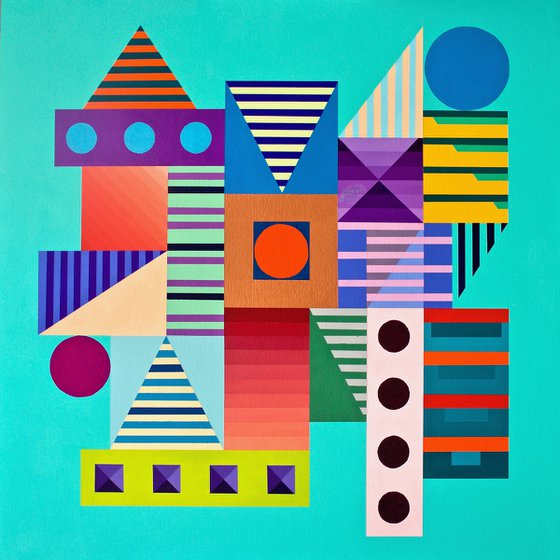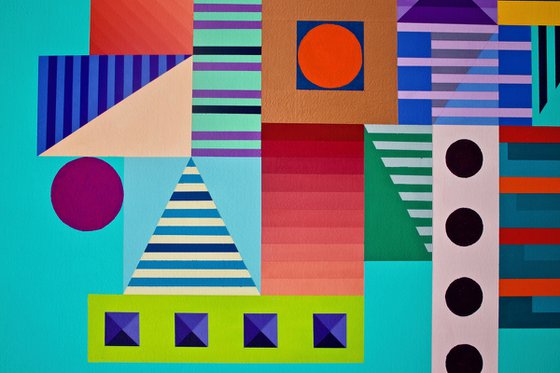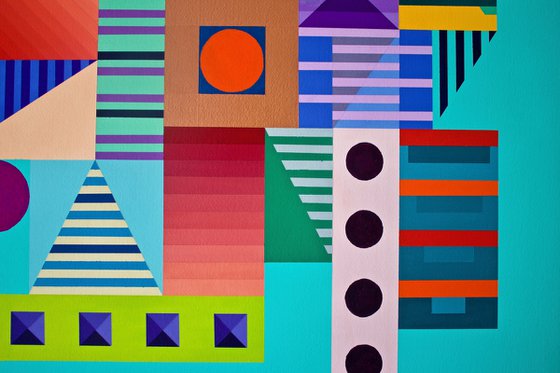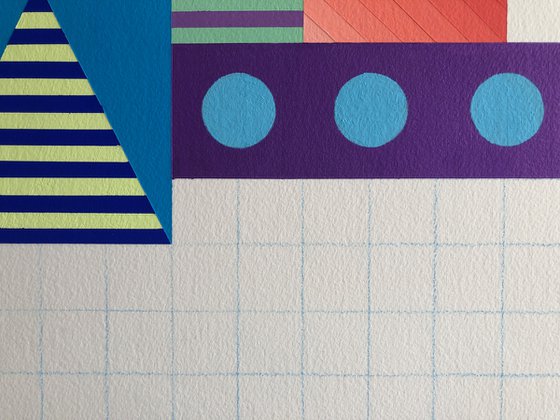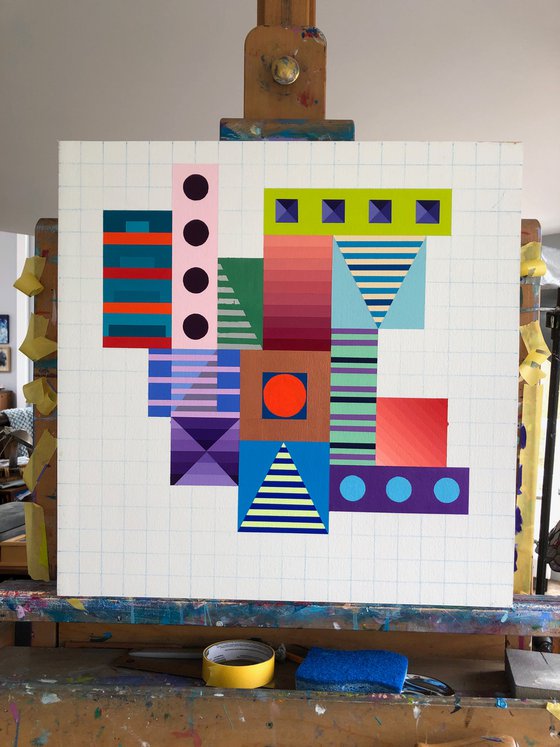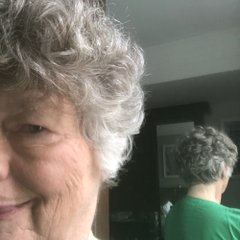- By medium
- By subject
- By budget
- Sales
- Gift cards
- Discover all art
- Artists
- Editors’ picks
- Ideas
Original artwork description:
The surface of my geometric abstracts are devoid of perceptible texture and traces of paint-handling, except for the slight ridges caused by the removed tape. I use acrylic gouache (low-binder, non-reflective, absorbent color). Triangles, squares, rectangles, rhomboids, and trapezoids are arranged in autonomous, non-hierarchical patterns that structure the compositional field across the entire surface. My subject is color and line, and the energy that arises through the juxtapositions created by abrupt transitions between pattern areas. Patterns are used repeatedly across separate works, although not bound by color or scale. I think of each pattern as a block reminiscent of a batik tjap, or a syntactical unit; thus the vocabulary of these works is comprised of fundamental, interchangeable, yet variable, units. Where a pattern is placed in relation to others in any given work, as well as variations in color and scale, offers infinite possibilities for structuring the surface. I regard this body of work as an extension of the movement away from gestural, expressionist abstraction, a movement advanced over the second half of the twentieth century by Barnett Newman, Kenneth Noland, Frank Stella, and Ellsworth Kelly, and to a less degree, Mark Rothko and Richard Diebenkorn. This tradition, advanced in the 1960s and 70s, is variously known as hard-edge abstraction or colorfield painting (but at times identified as minimal, cool, post-painterly, etc.). Several predecessors are important to me, particularly Victor Vasarely, Piet Modrian, Wassily Kandinsky, Paul Klee, Kasimir Malevich, and Islamic art in general. Among contemporary artists, I value the the paintings of Sarah Morris, Dion Johnson, John Matt and Bridget Riley.
This particular work is painted on 300-pound watercolor paper mounted on cradled birch panel and coated with damar varnish and a thin layer of cold wax that's been buffed for extra protection. It is signed on the back.
Materials used:
paper, varnish, wax, glue, wood
Tags:
#abstract #geometrical #copper #geometric abstract painting #patterned abstract #multi-coloredCopper Sun (2019) Acrylic painting
by Gray Jacobik
1 Artist Reviews
£755.65 Sold
- Acrylic painting on Paper on board
- One of a kind artwork
- Size: 50.8 x 50.8 x 3.81cm (unframed) / 50.8 x 50.8cm (actual image size)
- Ready to hang
- Signed on the back
- Style: Geometric
- Subject: Abstract and non-figurative
Do you like this artwork?
This artwork has sold, but the artist is accepting commission requests. Commissioning an artwork is easy and you get a perfectly personalised piece.
Loading
Original artwork description
The surface of my geometric abstracts are devoid of perceptible texture and traces of paint-handling, except for the slight ridges caused by the removed tape. I use acrylic gouache (low-binder, non-reflective, absorbent color). Triangles, squares, rectangles, rhomboids, and trapezoids are arranged in autonomous, non-hierarchical patterns that structure the compositional field across the entire surface. My subject is color and line, and the energy that arises through the juxtapositions created by abrupt transitions between pattern areas. Patterns are used repeatedly across separate works, although not bound by color or scale. I think of each pattern as a block reminiscent of a batik tjap, or a syntactical unit; thus the vocabulary of these works is comprised of fundamental, interchangeable, yet variable, units. Where a pattern is placed in relation to others in any given work, as well as variations in color and scale, offers infinite possibilities for structuring the surface. I regard this body of work as an extension of the movement away from gestural, expressionist abstraction, a movement advanced over the second half of the twentieth century by Barnett Newman, Kenneth Noland, Frank Stella, and Ellsworth Kelly, and to a less degree, Mark Rothko and Richard Diebenkorn. This tradition, advanced in the 1960s and 70s, is variously known as hard-edge abstraction or colorfield painting (but at times identified as minimal, cool, post-painterly, etc.). Several predecessors are important to me, particularly Victor Vasarely, Piet Modrian, Wassily Kandinsky, Paul Klee, Kasimir Malevich, and Islamic art in general. Among contemporary artists, I value the the paintings of Sarah Morris, Dion Johnson, John Matt and Bridget Riley.
This particular work is painted on 300-pound watercolor paper mounted on cradled birch panel and coated with damar varnish and a thin layer of cold wax that's been buffed for extra protection. It is signed on the back.
Materials used:
paper, varnish, wax, glue, wood
Tags:
#abstract #geometrical #copper #geometric abstract painting #patterned abstract #multi-colored14 day money back guaranteeLearn more
